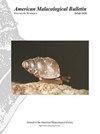Diet of Octopus hubbsorum (Cephalopoda: Octopodidae) from the Coast of Oaxaca, México
IF 0.4
4区 生物学
Q4 MARINE & FRESHWATER BIOLOGY
引用次数: 4
Abstract
Abstract: In this study, trophic ecology of Octopus hubbsorum (Berry, 1953) was examined in relation to the species life cycle and dry and rainy seasons. A total of 184 individuals were obtained from the commercial artisanal catches at different localities along the coast of Oaxaca, Mexican tropical Pacific, from January 2011 to December 2012. Analysis of digestive tract contents revealed that O. hubbsorum preyed upon 43 different prey species belonging to five zoological groups (Crustacean, Mollusca, Teleostei, Echinodermata and Polychaeta), cannibalism was only occasional. The most important prey was the porcelain crabs genus Petrolisthes, contributing 52.1% and 37.8% to the total Index of Relative Importance, in females and males, respectively. Dietary comparison between different maturity stages revealed significant changes in the diet with maturation. The proportion of empty stomachs observed between the dry (18.75 %) and rainy (12.5 %) seasons did not differ significantly (χ2 = 0.55, P > 0.05). Our results suggest that females likely migrate to shallow areas to feed in preparation for mating, they may do this to increase energy intake prior to egg caring and incubation, a period when they do not feed. The high productivity waters along the coast of Oaxaca seem to be important to the survival of this species because they offer key food resources at a critical reproductive stage.墨西哥瓦哈卡海岸章鱼的饮食(头足目:章鱼科)
摘要:本研究探讨了hubbsorum (Berry, 1953)章鱼的营养生态学与物种生命周期和旱季和雨季的关系。2011年1月至2012年12月,在墨西哥热带太平洋瓦哈卡州沿岸不同地点,通过商业手工捕捞共捕获184只个体。对其消化道内容物的分析表明,hubbsorum可捕食5个动物类群(甲壳类、软体类、硬骨类、棘皮类和多毛纲)43种不同的猎物,偶有同类相食现象。最重要的猎物为石石瓷蟹属,雌蟹和雄蟹的相对重要性指数分别为52.1%和37.8%。不同成熟期的日粮比较显示,日粮随成熟期的变化显著。干燥季节(18.75%)与雨季(12.5%)空腹比例差异无统计学意义(χ2 = 0.55, P < 0.05)。我们的研究结果表明,雌性可能会迁移到浅水区觅食,为交配做准备,它们这样做可能是为了在照顾卵子和孵化之前增加能量摄入,这段时间它们不进食。瓦哈卡沿岸的高生产力水域似乎对这个物种的生存很重要,因为它们在关键的繁殖阶段提供了关键的食物资源。
本文章由计算机程序翻译,如有差异,请以英文原文为准。
求助全文
约1分钟内获得全文
求助全文
来源期刊
CiteScore
1.00
自引率
40.00%
发文量
1
审稿时长
>12 weeks
期刊介绍:
The American Malacological Bulletin serves as an outlet for reporting notable contributions in malacological research. Manuscripts concerning any aspect of original, unpublished research,important short reports, and detailed reviews dealing with molluscs will be considered for publication. Recent issues have included AMS symposia, independent papers, research notes,and book reviews. All published research articles in this journal have undergone rigorous peer review, based on initial editor screening and anonymous reviewing by independent expertreferees. AMS symposium papers have undergone peer review by symposium organizer, symposium participants, and independent referees.

 求助内容:
求助内容: 应助结果提醒方式:
应助结果提醒方式:


